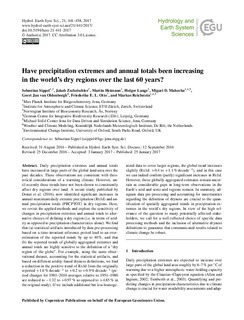| dc.contributor.author | Sippel, Sebastian | |
| dc.contributor.author | Zscheischler, Jakob | |
| dc.contributor.author | Heimann, Martin | |
| dc.contributor.author | Lange, Holger | |
| dc.contributor.author | Mahecha, Miguel D. | |
| dc.contributor.author | van Oldenborgh, Geert Jan | |
| dc.contributor.author | Otto, Friederike E.L. | |
| dc.contributor.author | Reichstein, Markus | |
| dc.date.accessioned | 2018-07-27T08:21:54Z | |
| dc.date.available | 2018-07-27T08:21:54Z | |
| dc.date.created | 2017-01-26T13:16:12Z | |
| dc.date.issued | 2017-01-25 | |
| dc.identifier.citation | Hydrology and Earth System Sciences. 2017, 21 (1), 441-458. | nb_NO |
| dc.identifier.issn | 1027-5606 | |
| dc.identifier.uri | http://hdl.handle.net/11250/2506659 | |
| dc.description.abstract | Daily precipitation extremes and annual totals have increased in large parts of the global land area over the past decades. These observations are consistent with theoretical considerations of a warming climate. However, until recently these trends have not been shown to consistently affect dry regions over land. A recent study, published by Donat et al. (2016), now identified significant increases in annual-maximum daily extreme precipitation (Rx1d) and annual precipitation totals (PRCPTOT) in dry regions. Here, we revisit the applied methods and explore the sensitivity of changes in precipitation extremes and annual totals to alternative choices of defining a dry region (i.e. in terms of aridity as opposed to precipitation characteristics alone). We find that (a) statistical artifacts introduced by data pre-processing based on a time-invariant reference period lead to an overestimation of the reported trends by up to 40 %, and that (b) the reported trends of globally aggregated extremes and annual totals are highly sensitive to the definition of a "dry region of the globe". For example, using the same observational dataset, accounting for the statistical artifacts, and based on different aridity-based dryness definitions, we find a reduction in the positive trend of Rx1d from the originally reported +1.6 % decade−1 to +0.2 to +0.9 % decade−1 (period changes for 1981–2010 averages relative to 1951–1980 are reduced to −1.32 to +0.97 % as opposed to +4.85 % in the original study). If we include additional but less homogenized data to cover larger regions, the global trend increases slightly (Rx1d: +0.4 to +1.1 % decade−1), and in this case we can indeed confirm (partly) significant increases in Rx1d. However, these globally aggregated estimates remain uncertain as considerable gaps in long-term observations in the Earth's arid and semi-arid regions remain. In summary, adequate data pre-processing and accounting for uncertainties regarding the definition of dryness are crucial to the quantification of spatially aggregated trends in precipitation extremes in the world's dry regions. In view of the high relevance of the question to many potentially affected stakeholders, we call for a well-reflected choice of specific data processing methods and the inclusion of alternative dryness definitions to guarantee that communicated results related to climate change be robust. | nb_NO |
| dc.description.abstract | Have precipitation extremes and annual totals been increasing in the world’s dry regions over the last 60 years? | nb_NO |
| dc.language.iso | eng | nb_NO |
| dc.relation.uri | http://www.hydrol-earth-syst-sci.net/21/441/2017/ | |
| dc.rights | Navngivelse 4.0 Internasjonal | * |
| dc.rights.uri | http://creativecommons.org/licenses/by/4.0/deed.no | * |
| dc.title | Have precipitation extremes and annual totals been increasing in the world’s dry regions over the last 60 years? | nb_NO |
| dc.title.alternative | Have precipitation extremes and annual totals been increasing in the world’s dry regions over the last 60 years? | nb_NO |
| dc.type | Journal article | nb_NO |
| dc.type | Peer reviewed | nb_NO |
| dc.description.version | publishedVersion | nb_NO |
| dc.rights.holder | © Author(s) 2017 | nb_NO |
| dc.subject.nsi | VDP::Landbruks- og Fiskerifag: 900 | nb_NO |
| dc.source.pagenumber | 441-458 | nb_NO |
| dc.source.volume | 21 | nb_NO |
| dc.source.journal | Hydrology and Earth System Sciences | nb_NO |
| dc.source.issue | 1 | nb_NO |
| dc.identifier.doi | 10.5194/hess-21-441-2017 | |
| dc.identifier.cristin | 1438312 | |
| dc.relation.project | Norges forskningsråd: 255061 | nb_NO |
| cristin.ispublished | true | |
| cristin.fulltext | original | |
| cristin.qualitycode | 2 | |

